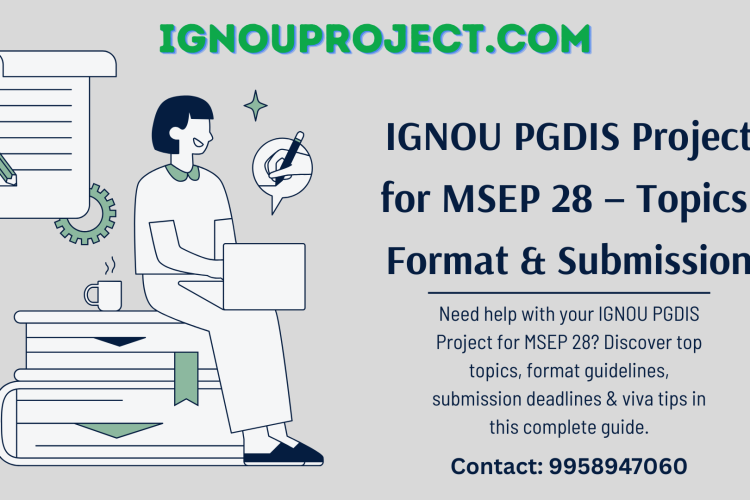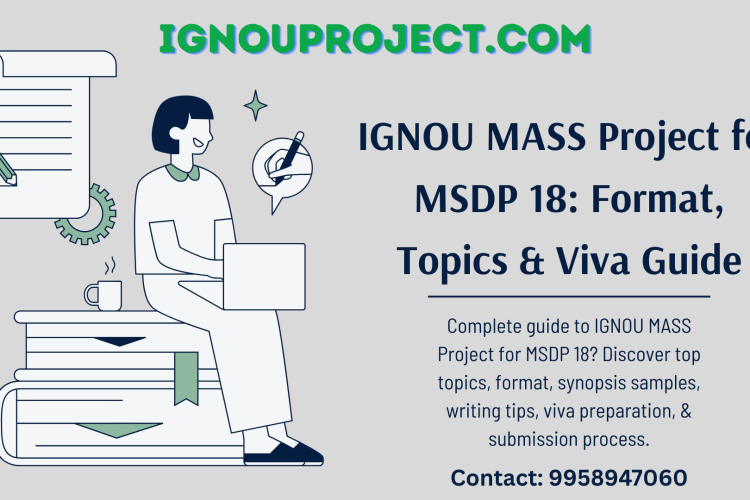
IGNOU PGDDM Project – If you’re looking for IGNOU PGDDM Project, you’ve come to the right site. Students interested in successfully downloading their next IGNOU PGDDM Project may do so by visiting this site and downloading the IGNOU MPAP 1 Project Sample Pdf. By acquiring the IGNOU MPAP 1 Project Sample Pdf and becoming familiar with the IGNOU PGDDM Project work format, students will save time and effort. Above all, utilise this post to download IGNOU MPAP 1 Project Sample Pdf, which can assist you in adequately preparing for your IGNOU PGDDM Project Work.
Whatsapp us to get the Personalized (Customized) IGNOU PGDDM Project Report and Synopsis
Download PDF Link for IGNOU PGDDM Project for MPAP 1
Preparation of IGNOU PGDDM Project Work
At the Post Graduate Diploma level, students are expected to acquire the skills, talents, and knowledge necessary to teach, do research, and perform professionally. MPAP-001, a dissertation project on disaster management, aims to partially meet this criterion. The goal of this PGDDM project is to enable and encourage you to:
- conduct independent and in-depth study on a topic of your choosing; and
- produce an organised and recorded piece of research work.
The PGDDM project carries four course credits. This means that the dissertation work will take approximately a year and will require approximately 120 study hours. The dissertation procedure begins with topic selection and concludes with the submission of a research paper of roughly 12000 words (excluding bibliographic references) demonstrating completion of specified duties. These are the responsibilities:
- Choosing a research subject
- Examining pertinent literature
- How to Write a Proposal for a Dissertation
- Data collection and evaluation
- Analyzing and interpreting data in relation to the study’s primary objectives
These responsibilities are fairly comparable to those associated with PhD research. However, resources and time are limited at the Postgraduate Diploma level. As a result, this dissertation is unlikely to provide a significant original contribution to the field of research. It is sufficient, however, to exhibit research abilities, even if a well-organized and conducted dissertation results in relevant and publishable discoveries. The University invites you to work on your dissertation independently. However, the dissertation work shall be guided by an Academic Supervisor recognised by the University.
Academic Supervisors for mentoring dissertations are all Academic Counsellors of the MPA-001 to MPA-007 Courses at the Study Centres and members of the Public Administration Faculty at the University headquarters. Additionally, you may approach any University/College professor who holds a doctorate in public administration/disaster management to supervise your dissertation project. If you wish to have an Academic Supervisor of your choice (from another university/college), email a brief bio-data about him/her to the Programme Coordinators in New Delhi for approval along with the dissertation proposal.
How to write IGNOU PGDDM Proposal/Synopsis (MPAP 1)?
You may submit a proposal/synopsis to your supervisor. The following steps can assist you in composing your IGNOU PGDDM Synopsis.
1) The Title of the Project
The project’s title should make it abundantly clear the nature and scope of the undertaking. It should be succinct, succinct, and precise. It is recommended that the subject is relevant to your field of employment.
2) Orientation
In the introduction, you can outline the subject, the study’s broad scope, why the subject is significant, and clarify key terms.
3) Confirmation of the title
The problem statement should include a brief analysis and description of the topic’s significance. To be more precise, this is a basis for conducting the study. The existing literature is evaluated and gaps in the knowledge base are identified to justify the study’s topic selection.
4) Goals
The objectives of the project should make it very clear why you are undertaking this venture. Typically, a topic will have between three and four objectives. These objectives may be established to aid in the concentration of your efforts. Consider the following hypothetical situation: You desire to conduct research on female kid dropout in a remote area. You might want to investigate the factors that contribute to the high dropout rate among individuals from diverse socioeconomic backgrounds. As a result, such objectives will aid in determining the scope of the investigation.
5) Hypothesis
The hypothesis is the most likely explanation for the current condition, as demonstrated by the project. However, not all investigations entail the testing of hypotheses (the majority of experiments do). You and your supervisor can decide on the type of research you wish to conduct. You may even choose to eliminate hypotheses from your analysis, given the estimated sample size of approximately 100 respondents.
6) Methodology of Research
If your PGDDM project will need fieldwork, you must first define the universe of the study. The phrase “universe” refers to the entire area or population sampled in a study. This will vary depending on the geographical scope and study unit of the study. For instance, if you are investigating the features of households in a village, the universe of your study will include all households. You will randomly select a subset of this universe.
7) Sampling Techniques
If your plan is based on field research, a random sample of the population must be chosen. A sample is a subset of the population. Sampling might be done randomly or in clusters. Consult any standard statistics book that you may have used in preparation for Research Methods in Disaster Management to have a better understanding of the various sampling approaches.
8) Data Collection Instruments
You should define the tools that will be used to gather data from several sources. Due to the intrinsic complexity and diversity of social reality, you may need to select multiple methodologies for a certain investigation.
9) Analysis of Data
After scrutinising and coding the raw data, statistical tools can be used to conduct data analysis. It is desirable to offer a description of the tactics you intend to employ in your proposal.
10) Tables
The tables will contain pertinent statistical data such as percentages, means, medians, standard deviations, and correlation coefficients.
Tables will be appropriately numbered (e.g., Chapter I will have Tables 1.1, 1.2, and so on; Chapter 2 will have Tables 2.1, 2.2, and so on). Following the table number will be a table title that should be as succinct as feasible while yet effectively summarising the contents of the table. If a table is derived from another source, the source should be noted below it. Three paragraphs can help you understand the table: I summarise the parameter or issue, (ii) offer an interpretation, and (iii) highlight significant findings-indications.
11) Chapter Organization
The chapter structure or chapter plan will serve as a guide for the report’s organisation. This activity will assist you in completing your dissertation efficiently and methodically.
How to write IGNOU PGDDM Project Report (MPAP 1)?
The IGNOU PGDDM Project is structured in the following manner;
- The IGNOU PGDDM Project should be approximately 20,000 words in length (including the title page, acknowledgements, and bibliographic references). While necessary statistical and documentary appendices such as questionnaires, surveys, interview schedules, and other data collection items may be included, they should be kept to a minimum.
- Dissertations should be typed or word processed on A4-size paper.
- With the exception of bibliographic references, all information in the dissertation’s main body should be 1.5-line spaced and printed on one side of the paper with one-inch margins.
- At the bottom-centre, pages should be numbered in ascending order.
- Between light plastic sheets, spiral-bind the completed dissertation and the accepted dissertation proposal.
The contents of the dissertation should be organised as follows:
- The title of the dissertation, the student’s name and enrollment number, the academic supervisor’s name, the degree programme for which the dissertation was written, the university’s name, and the month and year of submission should all be included on the dissertation’s cover page.
- The title page should contain the same information as the cover page, as well as the following statement: “This dissertation is submitted in partial fulfilment of the requirements for the Master of Political Science degree offered by the Indira Gandhi National Open University,” followed by the submission date (month and year).
- A letter from the Academic Supervisor certifying that the candidate’s dissertation is original work and that it should be given to the examiner.
- The Table of Contents should include a list of the dissertation’s chapters, with relevant sections, and their associated page numbers, as well as page numbers for bibliographic references and any figures, tables, or maps.
- Acknowledgements: You may like to express your appreciation for any assistance received while preparing the dissertation.
- The main text is divided into chapters (typically three or four, including an Introduction and Conclusion), bibliographic references, and, if necessary, appendices. Each chapter, bibliography, and appendix should begin on a different page; however, portions contained inside primary headings may continue on the same page. The primary text of the dissertation should be progressively numbered. The bibliography should include a list of all books cited in the chapters and any key sources studied during the dissertation’s development.
- At the conclusion of the dissertation, the Dissertation Proposal must be approved by the Faculty Committee.
Writing Tips for Enhancing your IGNOU PGDDM Project Work
By now, you should have a better idea of how an IGNOU PGDDM Project work should look. To summarise, the following additional tips can help you optimise the efficiency of your IGNOU PGDDM Project work;
- The dissertation should be presented logically and succinctly, using simple, everyday language and sentence structure. The language should be clear and proper, devoid of colloquialisms or slang. Personal pronouns such as I, we, you, my, our, and us should not be used. They should be replaced with the terms ‘researcher’ or ‘investigator’. Except for frequently understood abbreviations such as M.A., IQ, and so on, abbreviations should be avoided throughout the dissertation’s primary material.
- Unless they are frequently used in statistical discussions, numerals less than three figures, round numbers, and numbers that begin sentences should always be explicitly spelled. Furthermore, fractions are defined. Figures are used for decimals and percentages, however the term ‘percent’ is written out, e.g. 25%.
- By including a visual aspect into your dissertation, graphics and tables can assist in clarifying complicated themes. They should be utilised sparingly unless they are directly relevant to your dissertation and help the reader comprehend your points. Never use an image or table in place of text. If you do utilise another person’s graphic or table, you must provide credit to the creator as you would with any other quote.
- Writing typically takes longer than the majority of people believe. As a result, avoid waiting until the final few weeks before the submission deadline to begin writing; rather, begin as soon as possible.
- It is not necessary to begin with the first chapter when writing. You may begin writing at any point in the chapter other than word one. Begin with the most compelling evidence and succinct ideas.
- Create a chapter-by-chapter outline of the contents of your dissertation. This will assist with the organising and planning of the writing process. Additionally, it enables you to estimate the length of each chapter, identify which portions require additional work, and determine which content should be placed where.
- Divide lengthy portions of text with headers and subheadings. The more clues offered to the reader, the more easily the dissertation will be navigated and comprehended.
Read More:
- IGNOU PGDDM Project Report & Synopsis for MPAP-001
- IGNOU PGDDM PROJECT | IGNOU PGDDM REPORT | IGNOU PGDDM SYNOPSIS | IGNOU DISASTER MANAGEMENT PROJECT
Ready to get your IGNOU PGDDM Project Report and Synopsis Sample PDF for MPAP 1?
- Call us or WhatsApp us at: 9958947060, 9354637830
- Visit: IGNOUPROJECT.COM

